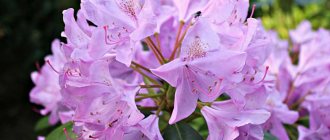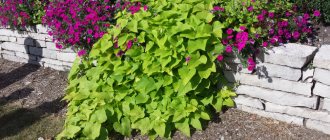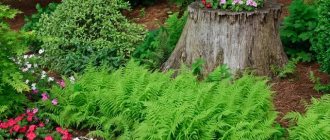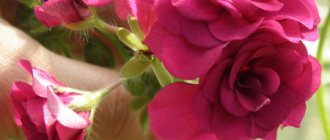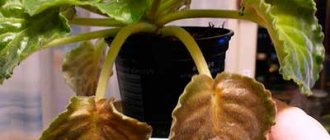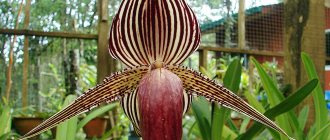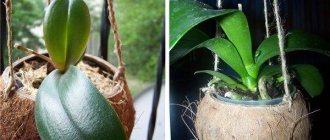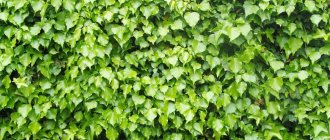The aster plant is represented by herbaceous annuals and perennials, and it belongs to the Asteraceae or Asteraceae family. According to information taken from various sources, this genus includes 200–500 species, most of which are naturally found in Central and North America. The plant came to Europe in the 17th century; it was brought secretly from China by a French monk. The name aster is translated from Latin as “star”. There is a Chinese legend about this flower, which says that 2 monks decided to reach the stars, they climbed higher and higher to the highest mountain in Altai, after many days they found themselves at the top, but the stars still remained distant and inaccessible. Exhausted by the hard road without food and water, they returned to the foot of the mountain, and a beautiful meadow with wonderful flowers opened before their eyes. Then one of the monks exclaimed: “Look! We were looking for stars in the sky, but they live on earth!” Having dug up several bushes, the monks brought them to the monastery and began to grow them, and it was they who gave them the stellar name “asters”. Since that time, such flowers in China have come to be considered a symbol of elegance, charm, beauty and modesty. Aster is the flower of those born under the sign of Virgo, a symbol of dreams of the unknown, a guiding star, a talisman, God's gift to man...
Brief description of cultivation
- Sowing . Seeds are sown in open soil in early spring (March) or before winter, and for seedlings - from mid to late March. Seedlings are planted in the garden in April or May.
- Bloom . In summer and autumn.
- Illumination . Well lit or shaded place.
- Soil . Nutritious loamy soil, cultivated to a depth of about 20 centimeters.
- Watering . Moderate. On hot days it is necessary to water more rarely, but more abundantly.
- Fertilizer . The aster needs to be fed three times throughout the season: 7 days after the seedlings appear, during the formation of buds and when flowering begins.
- Reproduction . Annual species and varieties are propagated only by seed, while perennials, as a rule, are propagated vegetatively, namely, by cuttings and dividing the bush.
- Harmful insects . Slobbering pennies, spider mites, leaf and root-knot nematodes.
- Diseases . Powdery mildew, ring spot, gray rot of flowers, verticillium wilt and viral jaundice.
When is it not recommended to plant asters?
There are days when it is not advisable to plant asters for seedlings in 2022. Astrologers have identified periods during which low germination and poor development of germinated seedlings will be observed. Unfavorable days are shown in the table and apply to both annual and perennial varieties.
| January | 11, 24-26 |
| February | 3, 8-9, 17, 21-23 |
| March | 9, 19-21, 24, 27 |
| April | 8, 16, 17, 21, 23 |
| May | 7, 13, 14, 22, 23 |
| June | 6, 9, 10, 21 |
Other periods, with the exception of those recommended for planting work, are called neutral. Sowing aster for seedlings is possible, but the quality of the resulting seedlings will not have any outstanding features.
Cyclic change of moon phases in 2022 - unfavorable days for planting and transplantation
Features of aster
Aster is a rhizomatous plant with simple leaf blades. Basket-inflorescences are part of corymbose or paniculate inflorescences. The baskets consist of marginal reed flowers of various colors, as well as central tubular flowers, which are very small and most often yellow. In European countries, aster cultivation began in the 17th century, and thanks to the tireless work of breeders, many incredibly beautiful varieties have appeared, and among them there are plants with flowers of various shapes and colors. As a rule, the seed method is used to propagate such a plant. Depending on the height of the shoots and the quality of the baskets, such flowers are used for group plantings, borders, rockeries, ridges, or as decoration for terraces and balconies. Asters make spectacular bouquets, and cut flowers can last quite a long time.
Annual asters - growing from sowing to flowering
Description of the perennial flower Astra
Thanks to the pointed shape of the petals, collected in a lush inflorescence, asters are associated with celestial stars. Many poets and writers sang its beauty in their works, and in ancient times the aster was endowed with mystical, symbolic qualities.
Photos of Aster flowers
Aster is a rhizomatous crop with simple dark green leaves located on an upright growing stem. The inflorescence of a flower is a basket collected from oblong, pointed petals. The color range of flowers is varied: snow-white, pink, bright red, purple, violet, yellow. Thanks to selection, the color spectrum of asters is constantly expanding. The varietal diversity includes annual and perennial specimens.
Growing aster from seeds
When to sow seeds in open ground
Seed propagation is most popular among gardeners. Asters can be grown either without seedlings or through seedlings. Early varieties are sown in open ground at the beginning of spring, or rather, in the first half of March, then the bushes will begin to bloom in July. Medium and late varieties are sown in the ground in the last days of April or in the first days of May, but the air temperature should not fall below 10 degrees. However, remember that flowers that were not grown from seedlings begin to bloom a little later compared to greenhouse bushes.
Sow the seeds in not very deep grooves (depth about 40 mm), after which they are well watered. And then the furrows are covered with earth, and when dry weather sets in, the surface of the area is sprinkled with a layer of mulch, or instead, the crops can be covered with covering material, which is removed immediately after the seedlings appear. After this, it is necessary to cover the crops only when there is a threat of frost. Thinning of seedlings is carried out during the formation of the second or third true leaf plate of the plants, while a distance of 10 to 15 centimeters must be maintained between seedlings. Excess plants can be transplanted to another area.
After sowing, early varieties begin to bloom after 90 days, mid-early varieties - after 110 days (in the first days of August), late varieties - after 120-130 days (in the last days of August or in the first half of September). In this regard, when choosing a specific variety, you can calculate when it will bloom. Flowering of late varieties can continue until the first hard frost.
Sowing seeds in open soil can be done both in spring and late autumn. In this case, they are sown in frozen soil in grooves made in advance. Pre-winter sowing is good because the plants grown the next year are very resistant to fusarium. After the seedlings appear in the spring, they should be thinned out. When choosing seed, it is necessary to take into account that the high germination rate of aster seeds is maintained during the first two years, and then it decreases by about half.
Sowing seeds for seedlings
Most experienced gardeners prefer to grow aster through seedlings, as this method is more reliable. The time for sowing seedlings depends on the variety and varies from the first days of April to May. When there are 7 days left before sowing, the seed must be wrapped in a piece of cloth, after which it is placed in a pinkish solution of potassium permanganate. After 10–12 hours, the fabric is wrung out so that no water flows from it, after which it is placed in a plastic bag and removed for germination in a place where it is always warm.
A pot or box is suitable for sowing seeds. The substrate should be nutritious and light; before sowing, it must be spilled with a solution of a fungicidal preparation. Make furrows in the soil mixture, and then evenly distribute the seeds, which should already sprout, into them. The furrows are covered with a half-centimeter layer of sand, then the crops are watered with a pinkish solution of potassium permanganate, using a fine sieve. Then the container is covered with glass (film) on top and put in a warm place (from 20 to 22 degrees). If the seed material is fresh (collected last season), then seedlings may appear after only 3–5 days. As soon as this happens, the crops should be removed to a cool place (about 16 degrees). When the plants have formed 3 or 4 true leaf plates, they need to be cut according to a 4x4 centimeter pattern. During picking, it is necessary to make sure to shorten the roots of the aster. For replanting, use a substrate combined with a small amount of wood ash. Planted plants need moderate watering.
Asters Will Rise with a Brush! Sowing Asters Without Picking.
Planting in open ground
When 7 days have passed after picking, the asters will need feeding with a solution of complex fertilizer. Then the bushes are systematically fed once a week with the same fertilizer until they are planted in the garden. When the seedlings grow and become stronger, they need to begin to be hardened; to do this, they are moved outside every day, and the duration of such procedures must be increased gradually. If done correctly, when it comes time to plant asters in the garden, they will have a powerful stem with 6-8 large green leaf blades. Experts advise transplanting seedlings into open soil in April or May. This plant is resistant to frost, and it can withstand a drop in temperature at night to 3-4 degrees. It is recommended to plant in the evening.
Landing rules
Before you start planting seedlings, you need to choose the most suitable site. It should be sunny and with well-drained soil. The best predecessors of such a crop are calendula and tagetes. These flowers grow very well in nutritious, light, neutral soil. The area for the aster must be prepared in advance. To do this, in the autumn, it is dug deep with the simultaneous application of compost or humus (per 1 square meter of land from 2 to 4 kilograms). In spring, the area is dug up again, and 15–20 grams of potassium salt, 20–40 grams of superphosphate and 15–20 grams of ammonium sulfate per 1 square meter are added to the soil. If the soil on the site is saturated with nutrients, then it is not necessary to add fertilizers to it.
Before planting the seedlings, the area is weeded, its surface leveled and loosened to a depth of 40 to 60 mm. It is also recommended to moisten the soil, especially if the aster seedlings are purchased and you do not know how long the root system of the bushes has been open. Make not very deep grooves and water them, and then asters are planted in them, keeping a distance between the bushes of at least 20 centimeters, and the distance depends on the variety of asters. The row spacing should be approximately 50 centimeters. The furrows are covered with dry soil, and the planted flowers do not need watering for 2–4 days from the moment of planting. After 7–15 days, the flowers will need fertilizing with nitrogen-containing fertilizers.
ASTER. SECRETS OF SUCCESSFUL GROWING.
How to propagate bush aster
Seeing in the photo a lush low plant dotted with bright star flowers, which looks especially stunning against the backdrop of nature preparing for winter, summer residents are interested in how the shrub aster reproduces and what needs to be done to decorate the site with such a miracle.
Growing from seeds
It is problematic to collect seeds for sowing from autumn varieties of perennials that bloom late, since they do not always have time to ripen, but bush aster seeds are sold in gardening centers and in online stores. Propagating a flower in this way, although it requires patience, allows you to grow strong bushes.
To breed a perennial aster in the yard or country house:
- The area dug up for sowing is loosened, rows are made up to 20 mm deep with an interval of about 20 cm.
- The soil in the furrows is irrigated, when the water is absorbed, seeds soaked in a solution of fungicide or potassium permanganate are laid out, trying to keep the distance between them at least a centimeter.
When the flowers grow 2 or 3 leaves, to prevent thickening of the planting, the aster is broken through, leaving 15 cm between the bushes.
Perennials are sown not only in spring, but also at the end of autumn, when the ground freezes, choosing one of the following methods:
- scatter seeds in the snow;
- scattered over the surface of the soil;
- placed in holes that are dug before frost.
The grains do not germinate before the onset of warm weather, and in March, along with the melting snow, they go deeper. Bush flowers planted before the onset of winter are strong and resilient. to diseases.
Division
As the aster grows, it loses its decorative value, begins to bloom less profusely, and requires replanting, which allows summer residents to plant the flowers they like. In the spring, before the onset of warm weather, the bush is dug up, cleared of soil and the root with strong shoots and two or three stems is divided into 3 or 2 parts. The sections are sprinkled with ash or treated with a solution of potassium permanganate.
The resulting new bushes are transplanted into the hole, watered abundantly and cared for as for adult plants. Four-year-old asters and older are used for division.
Propagation by cuttings
Another method is suitable for propagating autumn flowers. In the spring, a stem 15 to 20 cm long is cut from the top of the bush at an angle and shortened to the first bud. A bush aster cutting is dipped into a solution of a growth stimulator and a day later planted in soil diluted with sand and fertilized with peat.
If several branches of the bush aster are cut for propagation, an interval of 0.2 m to 30 cm is left between each one. The cuttings are placed at an angle to a depth of 10 cm. The seedlings are watered abundantly for the first month, when strong roots form and young shoots appear, the perennial flower ceases to need water frequent irrigation.
Caring for a garden aster
Aster is an unpretentious plant, so growing it in your garden is quite simple. The most important thing to remember is to loosen the soil surface in a timely manner, while removing all weeds. It is necessary to loosen the surface of the soil near the bushes every time watering is carried out or it rains, and the depth of loosening should not exceed 40–60 mm. Even before the bushes begin to branch, they should be hilled to a height of 60 to 80 mm, in which case their root system will develop much faster.
Watering
Aster is one of those plants that react extremely negatively to both dry soil and stagnation of liquid in it. During a long dry and hot period, watering should become more rare, but plentiful (about 30 liters of water per 1 square meter of land); after this procedure, it is necessary to loosen the soil surface. If the soil dries out, this may cause the inflorescences to become less spectacular.
Top dressing
In order for the bushes to be powerful and as decorative as possible, they will need systematic feeding. During one season, such flowers need to be fed at least three times:
- first feeding - 7-15 days after transplanting into the garden, for this, 10 grams of potassium sulfate, 20 grams of ammonium nitrate and 50 grams of superphosphate are added per 1 square meter of plot;
- the second - at the beginning of budding, for this purpose 50 grams of superphosphate and the same amount of potassium sulfate are added to the soil per 1 square meter;
- third - as soon as flowering begins, the same fertilizers are used for this as for the second feeding.
Do not forget to promptly remove inflorescences that have begun to fade.
Possible problems
As a rule, inexperienced gardeners may have problems growing asters in their garden plot. For example:
- After sowing, the seedlings do not appear, or they appear, but grow very slowly and dry out . In this case, experts advise reseeding, while strictly following all agrotechnical rules. Particular attention should be paid to the composition of the substrate, as well as to the pre-sowing preparation of the seed.
- Annuals are affected by fusarium . Remember that areas where representatives of the Solanaceae family (tomatoes, potatoes) or flower crops such as carnations, tulips, gladioli and gillyflowers were previously grown are not suitable for planting such flowers. These areas can be used for growing asters only after at least 5 years, as the likelihood that they will be affected by fusarium increases. For the same reasons, fresh manure is not used to feed bushes.
- The formed inflorescences are incomplete . This can happen due to the fact that spider mites or aphids have settled on the bushes, they feel a lack of nutrients, or due to non-compliance with the agrotechnical rules of the crop.
Diseases of asters
Fusarium
Most often, this crop is affected by fusarium. The causative agent of this disease is fungi of the genus Fusarium. Symptoms of damage appear in an adult bush, so it suddenly begins to wither, and only on one side, after which it begins to turn yellow, brown and wither. To date, experts have not found an effective method of combating fusarium; therefore, it is extremely important to follow preventive measures, namely, follow the rules of crop rotation and crop rotation on the site. In one area, aster should be planted alternately with other crops, and it can be replanted there no sooner than after 5 years. All affected bushes are dug up and destroyed immediately after their discovery, this will help prevent the spread of the disease.
Blackleg
Asters can also be affected by another fungal disease called “black leg”. As a rule, bushes are affected by it during the seedling period, the diseased plant darkens, and its root collar and base of the stem begin to rot. The development of the causative agent of this disease is observed in acidic soils. All affected bushes must be pulled out and destroyed, the soil mixture is spilled with a solution of potassium permanganate (1%), and the surface of the substrate around the seedlings is sprinkled with a layer of sand.
Rust
Such flowers can also be affected by rust, with swellings forming on the underside of the leaf blades, which contain spores. The foliage on the affected bushes begins to wither and dry out. The area where asters grow should be as far as possible from coniferous plants, since most often it is from them that rust spores fall onto the bushes. For preventive purposes, treat the plants with a solution of Bordeaux mixture (1%), and diseased bushes should be treated with the same product once every 7 days.
Jaundice of asters
This plant can also be affected by a viral disease called aster jaundice. It is caused by a virus carried by leafhoppers or aphids. At the very beginning, the color of the foliage becomes lighter, and then general chlorosis of the leaf blades sets in, and the bush begins to grow more slowly. The buds also develop poorly, which also turn pale green. In order to prevent the bushes from being affected by the disease, it is necessary to combat its carriers; for this, the bushes are treated with a solution of an insecticidal preparation, for example: Pirimor, Actellik or Pyrethrum. At the same time, diseased bushes are dug up and destroyed.
Bushes affected by verticillium or powdery mildew are recommended to be treated with Fundazol.
Why do asters dry up? Diseases of asters
Pests of asters
Aster can be harmed by insects such as the meadow bug, slobbering pennies, arable slug, common earwig, spider mite, bud aphid and cutworm. In order to protect such flowers, you need to adhere to a number of preventive measures:
- in the fall it is necessary to carry out deep digging of the site;
- the area is cleared of the remains of annual plants and stems of perennials, which die off by autumn, and it is recommended to destroy them;
- choose the right varieties of flower crops for your garden plot;
- if necessary, improve the soil by adding compost and humus or liming;
- Keep the recommended distance between the bushes, otherwise they will be elongated and weakened.
If you do notice harmful insects on flowers, then get ready to fight them either with chemicals or folk methods. To destroy arable slugs, you can use Metaldehyde or collect it by hand and then destroy it. Treatment with Fundazol will help in the fight against the common earwig. To get rid of cutworms, meadow bugs, slobbering pennies and spider mites, you need to use a solution of Phosfamide, Karbofos or Pyrethrum.
ASTER DIES FROM DISEASES AND PESTS
Landing in the ground
Young asters are transplanted into open ground when the length of the stem is at least 10 centimeters, and the plant itself has acquired several full leaves.
Prepare the site in advance, choosing places near the fences.
The earth is being dug up. There is no need to additionally fertilize the soil, but since asters are sensitive to its acidity, it is recommended to add lime.
The seedling is transferred to a permanent place with a lump of earth. The distance between the bushes is approximately 20 centimeters. After transplanting, the flowerbed is thoroughly watered.
Care after flowering
Pre-winter sowing
When the flowering of annual (garden) asters ends, it is recommended to remove the bushes from the soil and destroy them, as pathogenic microorganisms or pests could have settled on them. After the first frost, the aster seeds you have collected can be sown in open soil, but for this you should choose a different area. Sowing of seeds is carried out in previously prepared grooves, which are then covered with humus or peat. Some gardeners carry out winter sowing in December or January immediately in the snow. To begin with, crush the snow in the selected area and make grooves in it, into which the seeds are sown, do not forget to cover them with peat on top. The advantage of sowing seeds in the snow is that thaws cannot harm them. In the spring, when the snow cover has melted, it is recommended to cover the area from above with film, which facilitates the faster appearance of seedlings.
How to sow asters before winter. . Website "Garden World"
Collecting seeds
In order to collect seed material, you need to wait until the inflorescence on the bush of the variety that you really liked has withered. You can cut it off after its center darkens and a white fluff forms in it. The cut inflorescence should be placed in a paper bag where it can dry. Don't forget to write the variety and date of collection on the bag.
Please note that seeds collected last season have the best germination rate. And the seed that has been stored for 2 years or longer sharply loses its germination capacity.
Wintering perennials
Perennial asters can be grown in the same area for 5 years. As a rule, it is in the autumn that it is recommended to dig up, divide into parts and plant in a new place aster bushes that have reached the age of 5 years. During transplantation, try not to injure the plant's root system.
Such perennials are highly resistant to frost; therefore, they can easily winter in open soil. However, for some varieties, it is still better to cover young bushes for the winter with flying leaves, peat or spruce branches. Before covering the area, you need to cut off all the dried stems of the asters. With the onset of spring, the shelter is removed from the area, as a result of which the bushes will begin to grow faster and bloom earlier.
Selecting a location
Planting an aster and its future life begins with determining the most suitable place of residence for the plants. Such a place will be an area well illuminated by the sun's rays, or a small partial shade with loose soil.
The seedlings will feel great in the place where marigolds or calendula grew, but will not be very accepting of the territory that in the past was given over to gladioli, tulips, potatoes or tomatoes.
Types and varieties of asters with photos and names
Relative of asters
Not every gardener will be able to figure out whether an aster is in front of him or not. The fact is that there is a genus of asters, which is represented by perennial and annual species and varieties, which were discussed above. And there is also the so-called garden aster, which inexperienced gardeners mistake for an annual aster, but it is just a close relative of this plant. It would be more correct to call the annual aster Callistephus - this is a monotypic genus of flowering plants, native to China, it belongs to the Asteraceae or Asteraceae family. Callistephus is represented by annuals and biennials; gardeners call this plant “garden aster” or “Chinese aster”. A description of this single species of the genus was given by Carl Linnaeus in 1825, and he called it Aster chinensis. A. Cassini later separated it into a separate genus and gave it the name Callistephus chinensis, or Chinese callistemma. Simple or branched shoots are colored green, less often - dark red. The fibrous root system is well branched and quite powerful. Alternate leaf blades have petioles. The inflorescences are represented by baskets, and the fruit of such a flower is an achene. There are approximately 4 thousand varieties of this plant in cultivation, all of them are divided into approximately 40 groups. Most often, this particular plant is cultivated by gardeners and is mistaken for an annual aster.
Early flowering perennial asters
Perennial asters are divided into a couple of groups according to their flowering time, namely: autumn-blooming and early-blooming. There are not very many early-flowering asters, and this group includes only the following species: Alpine aster (Aster alpinus), Bessarabian aster (Aster bessarabicus) and Italian aster (Aster amellus).
alpine aster
Such perennials, blooming in May, can reach a height of 15–30 centimeters. The diameter of single baskets reaches 50 mm; in appearance they are similar to simple daisies. They are often used for rockeries. The best varieties:
- Glory - a bush reaches a height of about 25 centimeters, the diameter of the inflorescence is up to 40 mm, a bluish-blue chamomile with a bright yellow center;
- Wargrave - the height of the bush is about 0.3 m; in May-June it is decorated with pink inflorescences with a yellow center, which reach 40 mm in diameter.
Italian aster or chamomile
Flowering occurs in June–July. The height of the plant is about 0.7 m, large inflorescences-corythes reach up to 50 mm in diameter. These flowers are suitable for rockeries and rocky gardens. The best varieties:
- Rosea - the color of the tubular flowers is brownish, and the reed flowers are pink, flowering begins in June and lasts about 3 months;
- Rudolf Goeth - large scutes reach 40–50 mm in diameter, their tubular flowers are yellow, and their reed flowers are purple.
Aster Bessarabian, or false Italian
The height of the bush is about 0.75 m, it is decorated with a large number of lilac flowers with a pale brown center.
Autumn-blooming perennial asters
Autumn-blooming perennial asters include bush aster, New Belgian aster and New England aster.
Bush aster (Aster dumosus)
These are the earliest of the autumn-blooming asters. This plant is native to North America. The height of the bush can vary from 0.2 to 0.6 m. The shoots are heavily leafy, so even when the bushes are not blooming, they still look impressive and are very similar to boxwood bushes. The best varieties:
- Niobe and Alba flora Plena - the color of the inflorescences is white;
- Blue Bird - the height of a dwarf plant is about 0.25 m, the inflorescences are pale blue, like the taller Blue Bouquet and Lady in Blue.
New Belgian aster (Aster novi-belgii), or Virginian aster
This plant is widespread in mid-latitude gardens. There are vigorous varieties, the height of which is about 1.4 m, as well as dwarf varieties - bushes no higher than 0.3–0.4 m. Powerful bushes are decorated with paniculate inflorescences. Flowers can be colored white, blue and purple, as well as various shades of burgundy and pink. The best varieties:
- Snowsprite - the height of a dwarf variety is about 0.35 m, the color of the inflorescences is white;
- Jenny - the height of a dwarf bush is about 0.3 m, it is decorated with red flowers;
- Audrey is also a dwarf variety, about 0.45 m high, with pink inflorescences;
- Royal Velvet - the height of a medium-sized bush is about 0.6 m, the color of the flowers is violet-blue;
- Winston S. Churchill - medium-growing variety, about 0.7–0.75 m high, bright ruby flowers;
- Dusty rose - the height of a vigorous bush is about 100 cm, light crimson inflorescences reach about 40 mm in diameter;
- Desert Blue - this vigorous variety can also reach a height of about one meter, the diameter of the inflorescences is about 35 mm, and their color is bluish-lilac.
Application of Asters in garden design
These beautiful flowers are used as border borders. Plants highlight garden paths, creating beautiful compositions from other flora. For example, white Asters will organically complete a flower bed planted with flowers in orange or red tones.
These representatives of the flora are widely used not only for decorating garden space, but also for making bouquets. Persistent when cut, they often decorate autumn holidays and are the most popular and sought-after flowers of this season.
Possible difficulties and mistakes in growing
Asters are widespread everywhere due to their unpretentiousness.
But problems can arise if agricultural practices are violated. Seeds of the second year after collection reduce the germination rate of seedlings to 20%. And during picking, it is often discovered that neighboring plants are intertwined with their roots, which is why they have to be torn off.
Asters do not like soil with high levels of nitrogen and subsequent dense sowing. A small distance between individual bushes will lead to fungal and bacterial infections.
Prices for aster seeds
The cost of seeds depends on their variety. The price differs little in the regions. In retail and online stores you can find planting material from 13-15 rubles.
Instances with beautiful decorative characteristics will cost more - from 35 to 50 rubles. In any case, aster seeds are available for purchase by any garden plant lover.
By planting asters with seedlings, you can get strong plants. They will decorate flower beds until frost. At the same time, even novice gardeners will be captivated by the process of growing seeds.

